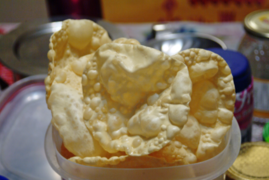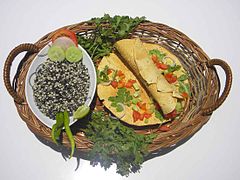Papadam
| Variations |
|
|---|---|
A papadam (also spelled poppadom, among other variants), also known as papad, is a snack that originated in the
Etymology
Papad is likely derived from the Sanskrit word parpaṭa (पर्पट), meaning a flattened disc described in early Jain and Buddhist literature.[1][2] Papad is known by several names in the various languages of India, e.g. (అప్పడం) in Telugu; appalam(அப்பளம்) in Tamil; happala in Kannada; papadam (පපඩම්) in Sinhala; pappadam in Malayalam; appadam papad in Marathi,[3] Punjabi and Gujarati; and pampad (ପାମ୍ପଡ) in Odia.[citation needed]
Spelling and pronunciation
Some divergence of transliteration may be noted in the third consonant in the
Regional variations

Papad recipes vary from region to region and from household to household. They are typically made from a flour or paste derived from lentils, chickpeas, black gram, rice, or potatoes.
Bikaner is the hub of chickpea and green gram papad manufacturing. Potato papad is made in Varanasi. Most sweet- and snack-selling national companies are also involved in this business. In the north, papads made in the city of Amritsar and its surrounds are especially famous. The Lijjat Papad company, headquartered in Mumbai, is a major manufacturer, and is often cited as an exemplar of the women's empowerment movement in India, as it is run entirely by women.
In most
, onion, tomato and coriander leaves is one of India's most popular appetizers.Ingredients and preparation
Papadam can be prepared from different ingredients and methods. One popular recipe uses flour ground from hulled split black gram[5] mixed with black pepper, salt, a small amount of vegetable oil and a food-grade alkali, and the mixture is kneaded. A well-kneaded dough is then flattened into very thin rounds and then dried and stored for later preparation and consumption. It may also contain rice, jackfruit, sago, etc., as main ingredients.
Cracked black pepper, red chili powder,
Gallery
-
Appadam
-
Rice papadam
-
Uradal papadam
-
Fire-toasting papadam
-
A Nepali thali with papad
-
Raw jackfruit papad incoastal Karnataka
-
Papadams with chutney are often served as an appetizer at South Asian restaurants around the world.
See also
- Indian bread – Wide variety of flatbreads and crêpes which are an integral part of Indian cuisine
- Sandige – Fried snack, originating from the Indian subcontinent
References
- ^ "Poppadom - Definition and synonyms of poppadom in the English dictionary". educalingo.com. Retrieved 22 September 2021.
- ^ "Lip-Smacking Ways to Use Papad: From Masala Papad to Rolls and Chaats". NDTV Food. Retrieved 12 September 2022.
According to food historian and author KT Achaya, "The parpata (papad) is first mentioned in about 500BC in Buddhist-Jain canonical literature, and the medical authorities note that they are made from pulses like urad, masoor, chana and the like."
- .
- ^ "Poppadom Dips Recipe (easy Indian dips)". 23 May 2023.
- ISBN 978-1-4613-0433-3.
- ^ "Poha papad,Rice flakes Papad, Summer Recipe". Udupi-Recipes. 11 March 2018. Retrieved 9 January 2020.
External links
 Media related to Papadams at Wikimedia Commons
Media related to Papadams at Wikimedia Commons








